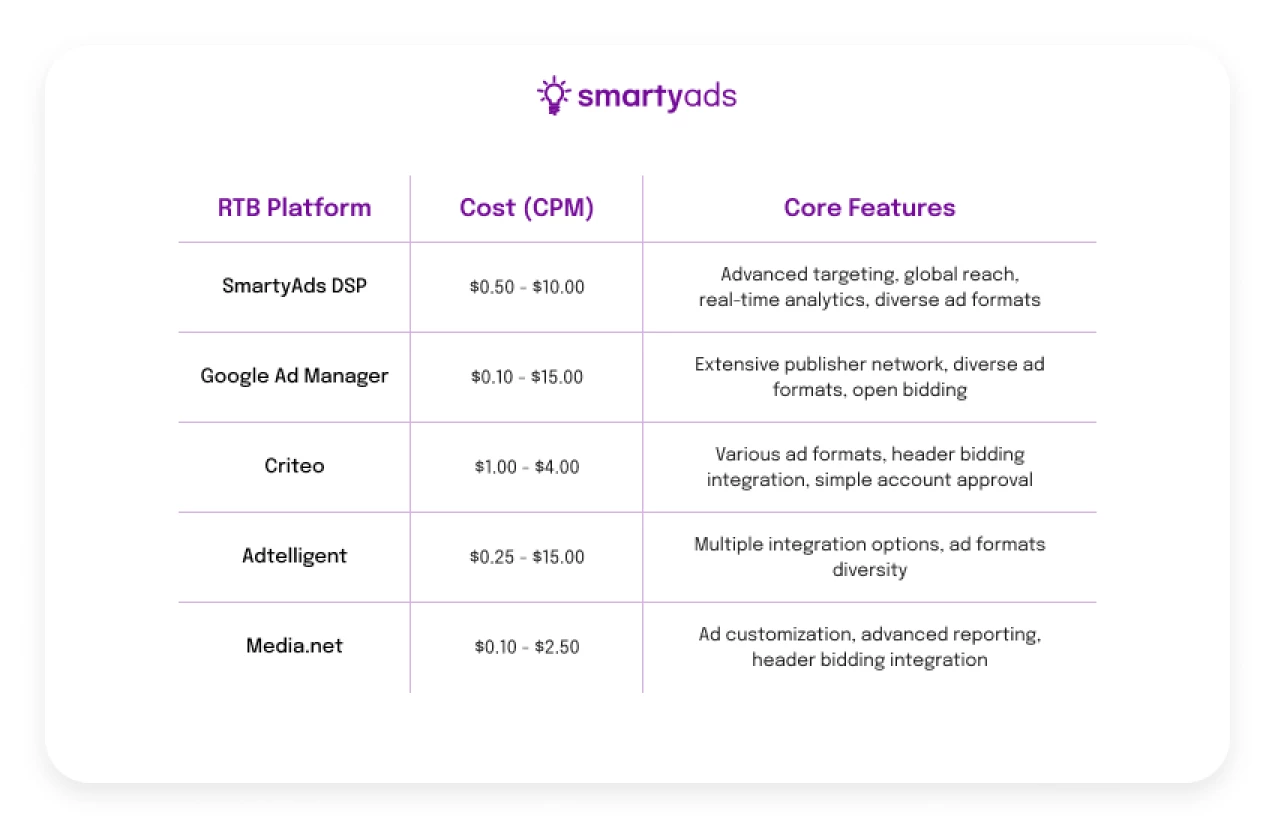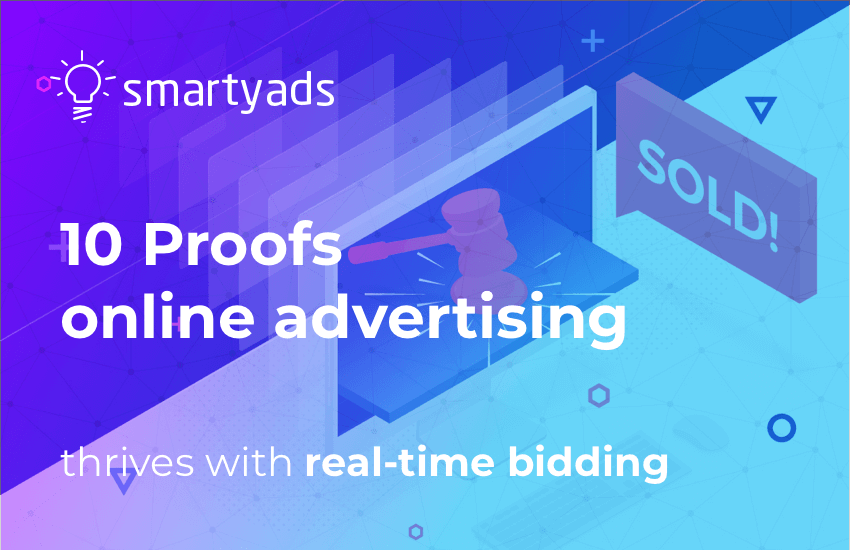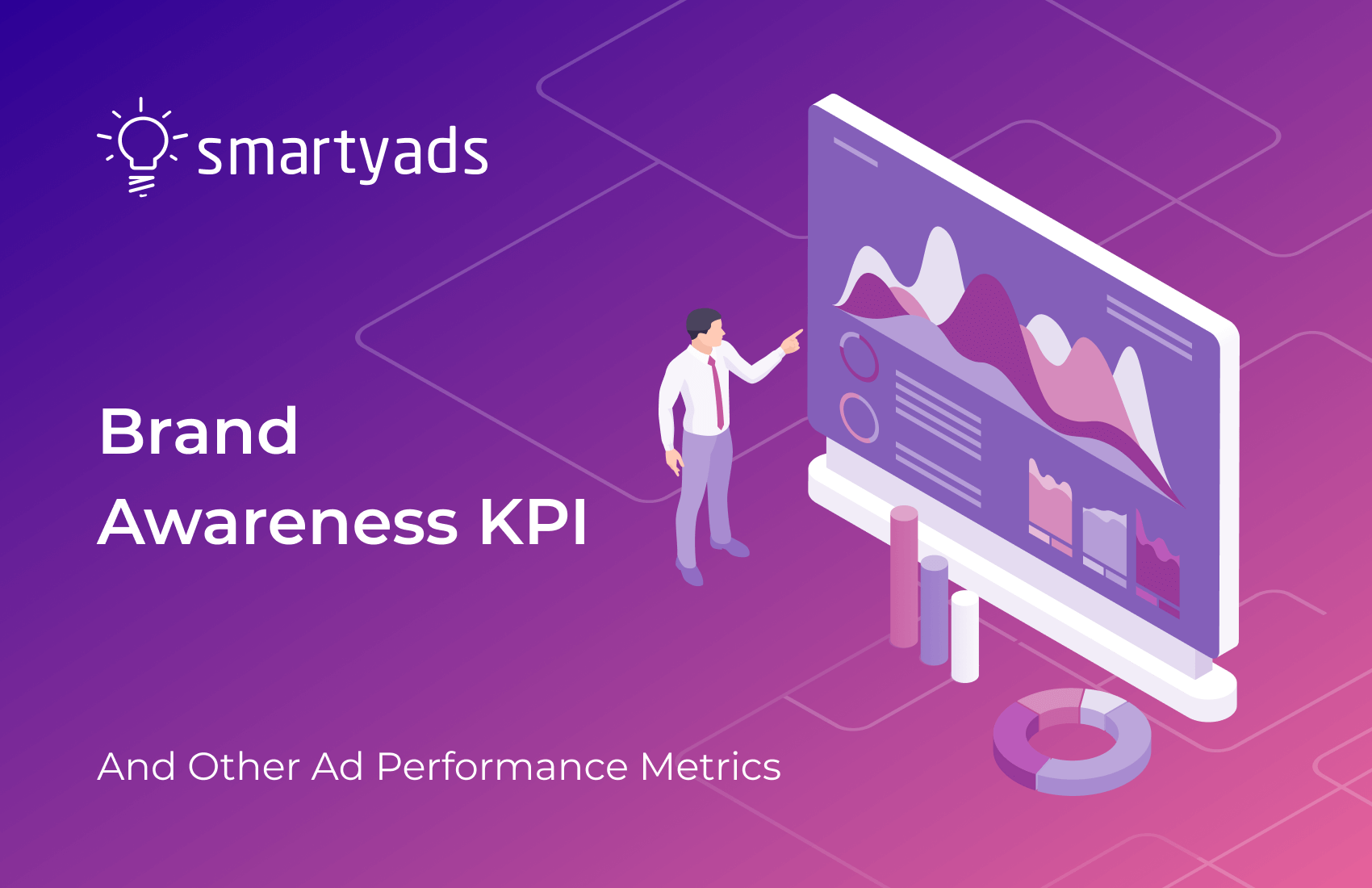Real-time bidding (RTB) is an online advertising concept that is hard to grasp for the programmatic advertising newbie. It might seem like it comprises too many components: from supply-side platform (SSP) and demand-side platform (DSP) to ad exchange (ad exchange definition here) and ad network, all taking part in the auction, buying, and selling ad inventory.
In today’s article, we will explore this powerful instrument, real-time bidding, in advertising and marketing. Keep reading to learn more about what RTB stands for in marketing, how it works, its main examples, and so much more.
Key Takeaways:
- Real-time bidding (RTB) is an automated process where advertisers compete in milliseconds for individual ad impressions, enabling highly targeted, cost-efficient campaigns across web, mobile, CTV, and video channels.
- It optimizes ad spend by allowing impression-by-impression purchasing, precise audience and contextual targeting, flexible budget controls, and instant strategy adjustments based on real-time performance data.
- The RTB ecosystem connects supply-side platforms (SSPs), ad exchanges, and demand-side platforms (DSPs) to provide broad publisher inventory access while minimizing wasted impressions and increasing campaign ROI.
- Key advantages include granular bid optimization, access to premium and niche audiences, transparent pricing, and actionable analytics for ongoing performance improvement.
- RTB supports campaigns of any size and budget, from small local advertisers to global brands, and is adaptable to multiple formats, devices, and targeting needs.
- These capabilities can be executed and scaled effectively through SmartyAds DSP, offering premium inventory, advanced targeting tools, and real-time optimization for maximum campaign impact.

What is RTB in marketing?
How could real-time bidding definition be wrapped up in simple words?
RTB is a way of buying and selling ad impressions through real-time automated bidding auctions. It enables advertisers to bid on certain ad placements based on their requirements to make sure that ads will be demonstrated to the most relevant audience at the right time. This system optimizes ad spend, reduces waste, and improves campaign outcomes.
Why is real-time bidding important?
Now, once you know what does RTB mean in marketing, we can move on further. The global RTB market reached a value of $11822 million in 2023. This number is expected to achieve $34699 million by 2030, demonstrating a CAGR of 16.63%. Why does it grow exponentially every year?
Efficient use of budget
It allows advertisers to set a targeting profile and choose a budget framework. In addition, it enables you to control how much money is to be spent in a day, how many ad impressions must be served, and many other custom parameters.
You will be able to effectively minimize wasted impressions and ensure that the budget is channeled to users who are more likely to convert.
Sophisticated audience targeting
With RTB, advertisers can choose what kind of target audience has to be reached. They can leverage detailed user data to bid on impressions that match their business needs, preferred demographics, and preferences which certainly results in more relevant and converting ad campaigns.
Real-time strategy optimization
The demand-side platform where usually RTB occurs, allows for optimizing ad campaigns. Advertisers can instantly adjust their bids and overall ad strategy based on real-time performance data.
Unique access to a broad inventory
Through RTB, advertisers can access a wide range of publishers and their ad inventory across multiple platforms. It’s possible to pick what kind of publisher websites are prioritized to reach diverse audiences and drive quality traffic. Also, it’s possible to mark the ad inventory that should be blacklisted.
Unprecedented campaign flexibility
Advertisers can launch and manage multiple campaigns simultaneously, as well as adjust bids and targeting according to their objectives. There are no long-term commitments or contracts.
How real-time bidding (RTB) works
RTB meaning in marketing is different from programmatic concepts. RTB merely represents one of the models of programmatic advertising, among which there are also direct ones, as well as non-auction-based, where publishers contact advertisers directly (much more information about the programmatic ecosystem you can find here).
The mechanism behind the RTB auction is the following: as a user opens the web browser and loads the target page he or she sees the ad banner — the product of the auction between advertisers wishing to serve an ad impression to this user, won by the one who was offering the highest bid request. The whole process is automated and takes no longer than 100 milliseconds to perform.
To enter an RTB environment and start participating in dynamic auctions, advertisers should join a demand-side platform. DSP systems simplify the process of ad inventory buying on a large number of advertising exchange platforms allowing the flexible price management for impressions and real-time bidding ad campaign setup. In order to start using DSP, an advertiser or marketer should register at DSP, and then deposit a small fee to the personal account. After this, the campaign can be launched.
So, on the other side of the programmatic reality, publishers use a software called a supply-side platform. It allows them to manage their digital advertising inventory and connect to demand partners through RTB.
In simple words, SSP packs the user data and sends a request to the ad exchange.
A bid request sent by the SSP to the ad exchange is like saying, “Hey look, this person has entered my page. Who wants to display reminder advertising here? How much are you ready to pay?” (read more about what is reminder advertising here).
The publisher’s bid request is a code that contains information about the user. In the bid request, the publisher’s SSP specifies the minimum price that will be accepted for this ad impression and the currency in which the transaction will be accepted.
When the bid request lands in the ad exchange, multiple DSPs start to process it. If the ad impression is valuable and matches the targeting and retargeting in digital marketing and budgeting settings of the advertiser, the DSP would bid on it by sending a bid response through the protocol.
DSPs specify the price that is ready to be paid for the ad impression. The DSP also sends the link to the ad creative in the bid response and mentions its parameters. After the publisher’s SSP collects all the bid responses, it analyzes them and chooses the highest. The following list represents what is a real-time bidding platform in terms of marketing benefits.

10 Proofs that RTB works in marketing
Campaigns for any size and budget
Today, RTB is used by various media buyers, from small, local business owners with $100 ad budgets to international, multimillion-dollar companies.
Broad publisher exposure
Through the RTB ecosystem, media buyers connect with a multitude of digital publishers, app developers, and blog and website owners — locally and worldwide. Accessing such a large pool of supply-side platform partners allows choosing the best ad inventory and premium audiences.
Affordable prices
Marketers optimize their advertising budget by setting price floors and daily or monthly spending limits for a campaign. This way, marketers can always be sure they buy ad impressions that go along with their financial objectives.
Audience buying
With RTB auctions, a marketer buys the publisher’s niche audiences thanks to cookie matching. The system uses first- and third-party data to analyze audience segments and build the profile of the target group.
Contextual audience targeting
Through RTB bidding auctions, marketers deliver consistent messages to the relevant public. It is possible to enhance user visiting, targeting according to their age, gender, social, and marital status, behavior and interests, location, device, etc.
Reduced wasted ad impressions
With precise RTB targeting, marketers can show ads to people who are interested in their product or service and most likely to perform the desired action (click, call, subscribe, or buy). This way, marketers pay only for impressions that bring value.
Impression-by-impression purchasing
Rather than buying ad impressions in bulk and never knowing where they will appear and what the engagement rate will be, marketers bid on one impression at a time. DSP analyzes every impression by given parameters and offers a different price for it depending on its value.
Bid optimization algorithm
Real-time bidding helps to minimize expenditures since it adjusts the bid according to the auction conditions in real time. This helps to win a targeted impression.
Real-time actionable data
Throughout the RTB campaign, marketers can analyze which strategies work and which fail, understand which creative drives the most engagement and which websites are performing better, and receive granular reports and statistics. From such robust data, marketers draw insights into how their real-time bidding campaign performs and optimize their future campaigns for even better revenues.
Managing multiple RTB campaigns
One DSP connects to a multitude of supply partners: SSPs, ad networks, and ad exchanges. This way, advertisers can access a diversity of supply parties through a single DSP interface running one, two, or more DSP ad campaigns at the same time.
Examples of RTB in marketing
Now, let’s dive into the core RTB examples.
Dynamic ad placement on websites
RTB auctions make it possible for advertisers to bid for ad space on websites in real time. This can ensure that the ads are displayed to the relevant audience based on demographics, user behavior, and preferences.
Real-time bidding in mobile advertising
Mobile apps often leverage RTB to deliver highly personalized ads to users. Advertisers can bid on ad spaces within mobile apps, targeting users based on location, device type, and other requirements.
Optimizing CTV ad campaigns with RTB
Connected TV advertising platforms leverage RTB to serve ads during streaming content. Advertisers bid for quality ad inventory that helps them reach viewers in the right context, which boosts their engagement.
Programmatic video ad auctions
RTB also gives advertisers possibility to participate in auctions for video ad placements across various platforms. They do this so their videos reach the right audience at the perfect time.
How much does real-time bidding cost?
The cost of real-time bidding can vary dramatically depending on multiple factors. These might include such as the target audience, placements, and competition among advertisers during the auction, etc. Usually, RTB is based on a cost-per-thousand-impressions (CPM) model. In this case, prices can range from a few cents to several dollars per 1000 impressions. Various platforms and DSPs offer RTB services, each with different pricing structures and features.
Here's an overview of some popular platforms and their costs: Keep in mind that these costs are approximate and can fluctuate a lot. Consider your budget and campaign goals when choosing an RTB platform. Contact us and we will help you calculate the average rates specifically for you.
Keep in mind that these costs are approximate and can fluctuate a lot. Consider your budget and campaign goals when choosing an RTB platform. Contact us and we will help you calculate the average rates specifically for you.
How to achieve your goals with SmartyAds?
With opportunities presented by real-time bidding, brands, media buyers, and marketers can finally display relevant messages to their target audiences. RTB has revolutionized online advertising, offering the possibility to purchase every ad impression independently rather than paying hundreds of dollars for a pack of a thousand impressions that bring minimum or no real value. Understanding the RTB meaning advertising helps optimize ad spending and enhance targeting for more effective campaigns.
Successful RTB advertising is what SmartyAds specializes in. For us, RTB is a universal tool that can help every publisher to sell ad inventory to the most interested media buyer, who is willing to pay the highest price and guarantee advertisers their ad is served to the right customer at the site with the best traffic quality.
The examples of real-time bidding impeccable performance along with our deep expertise in online advertising allow us to provide our clients with innovative real-time bidding marketing products that establish the highest effectiveness in ad tech. Our experienced professionals are eager to assist and support you in every stage of growing your RTB marketing campaign, from opening your account to tuning and optimizing your existing ad strategy in our system.
Ready to monetize your online business on open RTB auctions? Get started with our innovative DSP now!
FAQ
RTB allows precise audience targeting, real-time campaign optimization, flexible budgeting, and access to a wide range of publishers. It minimizes wasted impressions, improves engagement, and ensures advertisers pay only for valuable, relevant placements.
Yes. RTB works across websites, mobile apps, connected TV, and programmatic video. It allows advertisers to manage multiple campaigns simultaneously, optimize bids, and target audiences dynamically based on demographics, location, device, and interests.
RTB is usually priced via CPM (cost-per-thousand impressions) and can range from cents to several dollars per 1,000 impressions, depending on targeting precision, platform, and competition. Advertisers control budgets and can optimize spend to maximize ROI.
SmartyAds DSP enables automated access to multiple publishers and ad exchanges, precise audience targeting, real-time bid optimization, and performance tracking. It simplifies campaign management, ensuring every impression is relevant and cost-effective.





